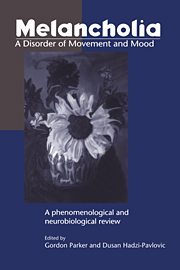Book contents
- Frontmatter
- Contents
- List of contributors
- Acknowledgments
- Introduction
- Part One Classification and Research: Historical and Theoretical Aspects
- 1 Issues in Classification: I. Some Historical Aspects
- 2 Issues in Classification: II. Classifying Melancholia
- 3 Issues in Classification: III. Utilising Behavioural Constructs in Melancholia Research
- 4 Issues in Classification: IV. Some Statistical Aspects
- Part Two Development and Validation of a Measure of Psychomotor Retardation as a Marker of Melancholia
- Part Three The Neurobiology of Melancholia
- The CORE Measure: Procedural Recommendations and Rating Guidelines
- References
- Author Index
- Subject Index
1 - Issues in Classification: I. Some Historical Aspects
from Part One - Classification and Research: Historical and Theoretical Aspects
Published online by Cambridge University Press: 04 August 2010
- Frontmatter
- Contents
- List of contributors
- Acknowledgments
- Introduction
- Part One Classification and Research: Historical and Theoretical Aspects
- 1 Issues in Classification: I. Some Historical Aspects
- 2 Issues in Classification: II. Classifying Melancholia
- 3 Issues in Classification: III. Utilising Behavioural Constructs in Melancholia Research
- 4 Issues in Classification: IV. Some Statistical Aspects
- Part Two Development and Validation of a Measure of Psychomotor Retardation as a Marker of Melancholia
- Part Three The Neurobiology of Melancholia
- The CORE Measure: Procedural Recommendations and Rating Guidelines
- References
- Author Index
- Subject Index
Summary
Introduction
The classification of the various types of depression – if types there be – is still to be resolved. Some proposed classifications have been widely accepted: the unipolar–bipolar dichotomy, and the removal of involutional melancholia from official classification systems in particular (Farmer and McGuffin 1989). Others, however, have not. In the case of melancholia, for example, the last 15 years have seen major changes in the consensus definition developed for the official nomenclature of dsm-iii, dsm-iii-r, and dsm-iv. Indeed the concept of melancholia as an entity is not universally accepted, as demonstrated by icd-10 (World Health Organization 1992) preferring the term “somatic” and acknowledging that “the scientific status of this syndrome is in any case questionable.”
The issue which has remained contentious, which in many ways drives the classification debate, and which is important to the theme of this book, is the relationship between the various forms of depression: in particular, the relationship between a genetically determined “constitutional” depression and those depressions (or that depression) which arise from psychosocial determinants. In British psychiatry the ground rules for the debate were set during the 1920s and 1930s by a handful of influential clinical studies which argued either for some form of dichotomy or for a unitary view of depression in which the various forms of depression lay along a continuum.
Background
In the 1920s, when the debate over depression classification in British psychiatry started (or restarted), there were a number of shaping influences.
- Type
- Chapter
- Information
- Melancholia: A Disorder of Movement and MoodA Phenomenological and Neurobiological Review, pp. 9 - 19Publisher: Cambridge University PressPrint publication year: 1996
- 5
- Cited by



